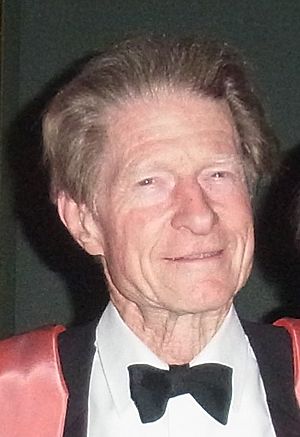John Gurdon facts for kids
Quick facts for kids
John Gurdon
|
|
|---|---|

Sir John Gurdon in 2012
|
|
| Born |
John Bertrand Gurdon
2 October 1933 Dippenhall, Surrey, England
|
| Died | (aged 92) |
| Citizenship | British |
| Alma mater | Eton College Christ Church, Oxford (MA, DPhil) |
| Known for |
|
| Awards |
|
| Scientific career | |
| Fields | Developmental biology |
| Institutions | |
| Thesis | Nuclear transplantation in Xenopus (1960) |
| Doctoral advisor | Michail Fischberg |
| Doctoral students | Douglas A. Melton Edward M. De Robertis |
Sir John Bertrand Gurdon (2 October 1933 – 7 October 2025) was a brilliant British scientist. He was a developmental biologist, which means he studied how living things grow and develop from a single cell. He is best known for his amazing discoveries in nuclear transplantation and cloning.
In 2009, he received the prestigious Lasker Award. Then, in 2012, he and Shinya Yamanaka were jointly awarded the Nobel Prize in Physiology or Medicine. They won this top science award for showing that mature cells, which are usually specialized, can be "reprogrammed" or changed back into stem cells. Stem cells are special cells that can develop into many different types of cells in the body.
Contents
Sir John Gurdon's Journey in Science
Sir John Gurdon attended Edgeborough prep school and then Eton College. Interestingly, he was not always at the top of his class in science. In fact, he ranked last in biology among 250 boys in his year! One of his teachers even wrote a report saying, "I believe he has ideas about becoming a scientist; on his present showing this is quite ridiculous."
Gurdon kept this report framed. He later said it reminded him that even when experiments don't work, which happens often in science, it's good to remember that maybe he wasn't so good at it after all. This shows that even great scientists face challenges and doubts.
He went on to Christ Church, Oxford, where he first studied classics (ancient Greek and Roman studies). He later switched to zoology, which is the study of animals. For his advanced degree, he studied how to move the nucleus of a cell in a type of frog called Xenopus.
After more research in California, he returned to England. He worked at the University of Oxford and later at the MRC Laboratory of Molecular Biology. In 1989, he helped start the Wellcome/CRC Institute for Cell Biology and Cancer at Cambridge, where he was chairman for many years.
Sir John Gurdon married Jean Elizabeth Margaret Curtis. They had a son and a daughter.
Groundbreaking Research and Discoveries
Cloning a Frog: Nuclear Transfer
In 1958, while at the University of Oxford, Gurdon achieved something truly remarkable. He successfully cloned a frog! He did this by taking the nucleus (the control center of a cell) from a normal body cell of a Xenopus tadpole. He then put this nucleus into a frog egg that had its own nucleus removed. This experiment showed that the nucleus from a specialized body cell still contained all the information needed to create a whole new organism.
This work was very important because it changed how scientists thought about development. It showed that cells don't lose their genetic instructions as they become specialized. The techniques he developed for moving cell nuclei are still used by scientists today. The word "clone" comes from an ancient Greek word meaning "twig," and it was first used for animals in 1963 to describe Gurdon's amazing results.
Studying Genetic Instructions
Gurdon and his team also found new ways to study how cells use genetic instructions. They used Xenopus frog eggs to understand how messenger RNA (mRNA) molecules work. mRNA carries instructions from DNA to make proteins. This technique helped scientists identify what proteins different genes make and how these proteins function.
Later Discoveries in Cell Reprogramming
In his later research, Gurdon focused on understanding the signals that tell cells what to become. He also studied the exact ways that a cell's nucleus can be "reprogrammed" or reset, like he did in his early cloning experiments. This included looking at how chemical tags on DNA affect cell identity.
Honours and Awards for Scientific Excellence
Sir John Gurdon received many honours and awards throughout his career. He was elected a Fellow of the Royal Society (FRS) in 1971, which is a very high honour for scientists in the UK. He was also made a Knight in 1995 for his important contributions to developmental biology.
In 2004, a research institute at Cambridge was renamed the Gurdon Institute in his honour, showing how much his work was valued.
The Nobel Prize
In 2012, Gurdon was awarded the Nobel Prize in Physiology or Medicine along with Shinya Yamanaka. They received this incredible award for their discovery that mature, specialized cells can be "reprogrammed" to become pluripotent cells. This means these reprogrammed cells can then turn into almost any other cell type in the body. This discovery has opened up new possibilities for understanding diseases and developing new treatments.
Death
Sir John Bertrand Gurdon passed away on 7 October 2025, at the age of 92. His pioneering work continues to inspire scientists around the world.
See also
 In Spanish: John Gurdon para niños
In Spanish: John Gurdon para niños

